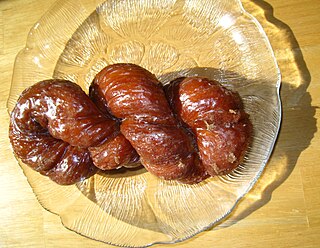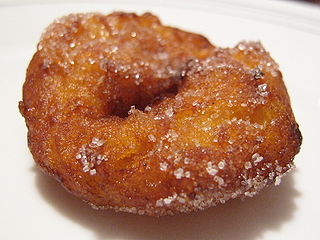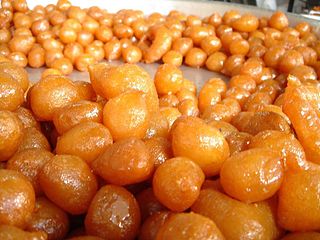
Cannoli are Sicilian pastries consisting of tube-shaped shells of fried pastry dough, filled with a sweet, creamy filling containing ricotta—a staple of Sicilian cuisine. They range in size from 9 to 20 centimetres. In mainland Italy, they are commonly known as cannoli siciliani.

A doughnut or donut is a type of food made from leavened fried dough. It is popular in many countries and is prepared in various forms as a sweet snack that can be homemade or purchased in bakeries, supermarkets, food stalls, and franchised specialty vendors. Doughnut is the traditional spelling, while donut is the simplified version; the terms are used interchangeably.

Beignet is a type of fritter, or deep-fried pastry, made from pâte à choux, but may also be made from other types of dough, including yeast dough. In France there are at least 20 different versions. They can vary in shape, the flour used for the dough, and the filling. They are popular in French, Italian, and French-American cuisines.

A churro is a type of fried dough from Spanish and Portuguese cuisine, made with choux pastry dough piped into hot oil with a piping bag and large closed star tip or similar shape. They are also found in Latin American cuisine, Philippine cuisine, and in other areas that have received immigration from Spanish and Portuguese-speaking countries, especially in the Southwestern United States and France.

Shawarma is a Middle Eastern dish that originated in the Levant region of the Arab world during the Ottoman Empire, consisting of meat cut into thin slices, stacked in an inverted cone, and roasted on a slowly turning vertical rotisserie or spit. Traditionally made with lamb or mutton, it may also be made with chicken, beef or veal. Thin slices are shaved off the cooked surface as it continuously rotates. Shawarma is a popular street food throughout the Arab world and the Greater Middle East.

A cruller is a deep-fried pastry like a doughnut popular in Europe and North America often made from a rectangle of dough with a cut made in the middle that allows it to be pulled over and through itself, producing twists in the sides of the pastry. The cruller has been described as resembling "a small, braided torpedo". Some other cruller styles are made of a denser dough somewhat like that of a cake doughnut formed in a small loaf or stick shape, but not always twisted. Crullers may be topped with powdered sugar or icing.

Funnel cake is a regional sweet food popular in North America, found mainly at carnivals and amusement parks. It is made by deep-frying batter.

Fried dough is a North American food associated with outdoor food stands in carnivals, amusement parks, fairs, rodeos, and seaside resorts. "Fried dough" is the specific name for a particular variety of fried bread made of a yeast dough; see the accompanying images for an example of use on carnival-booth signs. Fried dough is also known as fry dough, fry bread (bannock), fried bread, doughboys, elephant ears, beaver tails, scones, pizza fritte, frying saucers, and buñuelos. These foods are virtually identical to each other and some yeast dough versions of beignets, and recognizably different from other fried dough foods such as doughnuts or fritters.

Jalebi is a popular sweet snack in South Asia, the Middle East, Africa and Mauritius. It goes by many names, including jilapi, zelepi, jilebi, jilipi, zulbia, jerry, mushabak, z’labia, zengoula or zalabia.

Tulumba or Bamiyeh is a deep-fried dessert found in Egypt, Turkey and the regional cuisines of the former Ottoman Empire. It is a fried batter soaked in syrup, similar to jalebis and churros. It is made from unleavened choux pastry dough piped with a pastry bag using an open star or similar tip. It is first deep-fried to golden colour and then sugar-sweet syrup is poured over it when still hot. It is eaten cold.

A buñuelo (Spanish:[buˈɲwelo], alternatively called boñuelo, bimuelo, birmuelo, bermuelo, bumuelo, burmuelo, or bonuelo, is a fried dough fritter found in Spain, Latin America, and other regions with a historical connection to Spaniards, including Southwest Europe, the Balkans, Anatolia, and other parts of Asia and North Africa. Buñuelos are traditionally prepared at Christmas. It will usually have a filling or a topping. In Mexican cuisine, it is often served with a syrup made with piloncillo.

Lokma is a dessert originated from Egypt made of leavened and deep fried dough balls, soaked in syrup or honey, sometimes coated with cinnamon or other ingredients. The dish was described as early as the 13th century by al-Baghdadi as luqmat al-qādi, "judge's morsels".

Baklava is a layered pastry dessert made of filo pastry, filled with chopped nuts, and sweetened with syrup or honey. It was one of the most popular sweet pastries of Ottoman cuisine.

A great variety of cassava-based dishes are consumed in the regions where cassava is cultivated, and the ingredient is included many national or ethnic specialities.

Betawi cuisine is rich, diverse and eclectic, in part because the Betawi people that create them were composed from numbers of regional immigrants that came from various places in the Indonesian archipelago, as well as Chinese, Indian, Arab, and European traders, visitors and immigrants that were attracted to the port city of Batavia since centuries ago.

Dumpling is a broad class of dishes that consist of pieces of cooked dough, often wrapped around a filling. The dough can be based on bread, wheat or other flours, or potatoes, and it may be filled with meat, fish, tofu, cheese, vegetables, or a combination. Dumplings may be prepared using a variety of cooking methods and are found in many world cuisines.

Paratha is a flatbread native to the Indian subcontinent, with earliest reference mentioned in early medieval Sanskrit text from Karnataka, India; prevalent throughout the modern-day nations of India, Sri Lanka, Pakistan, Nepal, Bangladesh, Maldives, Afghanistan, Myanmar, Malaysia, Singapore, Thailand, Mauritius, Fiji, Guyana, Suriname, and Trinidad and Tobago where wheat is the traditional staple. Paratha is an amalgamation of the words parat and atta, which literally means layers of cooked dough. Alternative spellings and names include parantha, parauntha, prontha, parontay, paronthi (Punjabi), porota, paratha, palata, porotha, forota, farata, prata, paratha, buss-up shut, oil roti and Roti Canai in Malaysia.

Zalabiyeh or Pitulici is a fritter or doughnut found in several cuisines across the Arab world, West Asia and some parts of Europe influenced by the former. The fritter version is made from a semi-thin batter of wheat flour which is poured into hot oil and deep-fried. The earliest known recipe for the dish comes from a 10th-century Arabic cookbook and was originally made by pouring the batter through a coconut shell. Zalabiyeh is also the Arabic language term used by Mizrahi Jews for a deep-fried yeast dough, often topped with either honey or syrup, and known as burmuelos in Ladino.




















